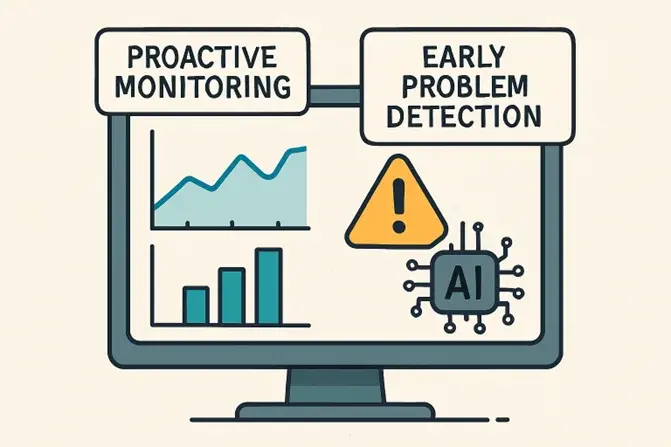Table of Contents
ToggleIntroduction
As the backbone of modern enterprises, digital infrastructure must be robust, agile, and capable of withstanding unexpected challenges. Ensuring this resilience requires more than reactive troubleshootingŌĆöit mandates a forward-thinking approach to monitoring and maintenance. Organizations can dramatically reduce the risk of downtime and disruption by leveraging proactive application monitoring solutions from trusted providers like eG Innovations.
Proactive monitoring goes beyond merely identifying issues after they arise. It utilizes continuous data collection and intelligent analytics to spot potential problems before they translate into operational setbacks. With digital transformation accelerating across industries, the need to adopt best practices in monitoring tools and strategies has never been more pressing for ensuring seamless business operations.
This approach not only helps organizations future-proof their technology stacks but also enables them to maintain a competitive edge. It ensures that users and customers experience unwavering service reliability, paramount in todayŌĆÖs customer-centric digital economy. Proactive monitoring is a key pillar in building resilient businesses that can pivot, scale, and adapt confidently.
In parallel, IT leaders must keep pace with rapid advancements in observability and monitoring methods. As businesses rely more on software and cloud-based ecosystems, an integrated, insight-driven monitoring strategy is foundational to success.
The Importance of Proactive Application Monitoring
Traditional monitoring practices focus on resolving problems post-occurrence, which can be costly and damaging in the age of always-on services. Proactive application monitoring, by contrast, is built on the prevention principle. This involves continuously assessing key system metricsŌĆösuch as load times, response rates, and error frequenciesŌĆöto identify risks early. When incorporated at scale, it allows IT teams to circumvent incidents that might otherwise lead to costly outages.
The shift to proactive methods is especially urgent given the complexity of modern digital environments. Hybrid cloud ecosystems, distributed microservices, and interconnected platforms have made simple, siloed monitoring defunct. Instead, holistic and proactive strategies are required to encompass all facets of modern infrastructure. Explore resources like the CIOŌĆÖs overview of application performance monitoring for further industry perspectives on evolving monitoring needs.
Integrating AI and Machine Learning for Predictive Maintenance
One of the most significant advancements in application monitoring has been the integration of artificial intelligence and machine learning (AI/ML). These technologies have moved monitoring beyond static threshold alerts toward dynamic, real-time analysis. AI and ML algorithms ingest large volumes of operational data, learning from patterns and proactively highlighting anomalies that would otherwise go unnoticed.
Fueled by AI/ML, predictive maintenance offers organizations a way to predict failures and prescribe next steps, further shrinking the window between insight and action. This reduces unplanned downtime, optimizes resource utilization, and lowers operational costs. As machine learning models improve, they empower IT teams to intervene before a minor latency or resource spike grows into a customer-facing incident.
Full-Stack Observability: A Holistic Approach
With modern IT landscapes spanning everything from legacy on-premises applications to complex, multi-cloud deployments, piecemeal visibility is no longer enough. Full-stack observability allows IT teams to monitor every layerŌĆönetworks, servers, databases, applications, user actions, and third-party dependenciesŌĆöin a unified view.
By connecting monitoring data across each layer, organizations can quickly trace the root cause of performance issues, even when fault lines cut across systems. Full-stack observability solutions are increasingly leveraging advanced data correlation and visualization, removing silos and allowing more profound insight into the health and performance of the entire ecosystem. For a broader market perspective, GartnerŌĆÖs discussion on full-stack observability underscores why this approach is critical for digital success.
Digital Experience Monitoring (DEM): Focusing on User Satisfaction
The ultimate yardstick for any digital initiative is user satisfaction. Digital Experience Monitoring (DEM) shifts the monitoring paradigm from mere system-centric metrics to focus on what users actually experience. DEM encompasses availability, responsiveness, and usability as measured directly from the userŌĆÖs point of viewŌĆöregardless of location, device, or network conditions.
By capturing granular, real-time data about end-user journeys and automating feedback loops into improvement cycles, DEM enables organizations to resolve friction points before they impact customers or employees. This proactive approach ensures that business objectives align with customer expectations, supporting customer retention, brand loyalty, and long-term growth. Consider exploring resources like Dynatrace’s overview of Digital Experience Monitoring for more insights into DEM.
Implementing Proactive Monitoring Strategies
The path to effective proactive monitoring involves a series of strategic and tactical steps:
- Assess Current Infrastructure:┬ĀAudit legacy and modern systems to identify vulnerabilities and critical paths requiring enhanced monitoring visibility.
- Select Appropriate Tools:┬ĀChoose technology stacks and tools that can be integrated smoothly and scaled as needs grow, without adding unnecessary complexity.
- Integrate AI and Machine Learning:┬ĀEmbed AI and machine learning to move from reactive to predictive problem resolution and to automate anomaly detection.
- Establish Full-Stack Observability:┬ĀUnify monitoring capabilities across infrastructure, code, and user experience to break down troubleshooting silos.
- Focus on User Experience:┬ĀBuild DEM into your strategy to keep user satisfaction at the core of digital transformation initiatives.
Conclusion
Proactive application monitoring has become essential for sustaining digital infrastructure’s resilience, reliability, and adaptability in modern business. Organizations can detect anomalies early, prevent disruptions, and optimize performance across complex systems by leveraging advanced tools such as AI-driven analytics, machine learning, full-stack observability, and digital experience monitoring. This forward-looking approach minimizes downtime, improves operational efficiency, reduces costs, and ensures seamless user interactions. In highly competitive markets where customer expectations are higher than ever, delivering consistent, high-quality digital experiences can set an enterprise apart. Beyond problem detection, proactive monitoring fosters innovation by providing actionable insights into system behavior, application trends, and user needs. By adopting and continuously refining these strategies, businesses strengthen their capacity to meet evolving demands and maintain long-term success.

